Can I Use Bonami To Clean Oven?
- Home
- Sharpening Guide
- Bring Out a Hamon Line
Easiest ways to bring out a hamon line
There are many ways to bring out a hamon line to get in 'pop' if it is a bit subtle - from the traditional style which takes day later day (after day) of polishing by paw using hazuya and jizuya polishing stones (and is a skill that takes a Japanese Toshigi 10 years to master), to mod hybrid polishing techniques, doing an acid or a lemon etch to bring out the hamon line details and quite a few more than tricks and techniques - many of which we will encompass here.
Only first, let'southward apace take a look at the hamon in a bit more detail to understand exactly what we are bringing out..
QUICK Spring MENU
Two master styles - Hadori and Classical hamon
Traditional Japanese Method (hardest way)
Hybrid Polishing (hard style)
Acid Etching with lemon or vinegar (easy way)
Acid Etching with Ferric Chloride (easier manner)
The EASIEST WAY - Red Iron Oxide
Can you actually smooth a hamon away? And what is it anyhow..
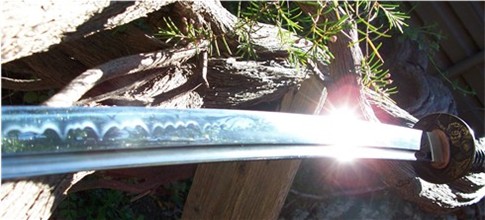
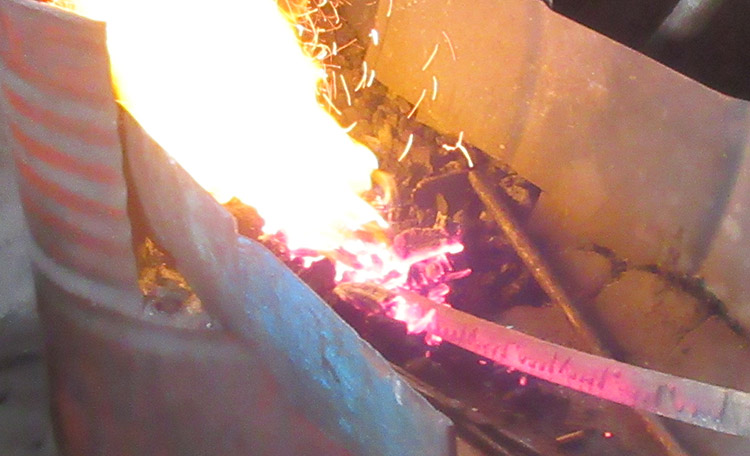
Okay, to keep it simple - the hamon is a visual past product of a traditional technique called differential hardening - the spine of the bract is clayed while leaving the edge exposed, heated up until it is ruddy hot for a few minutes and then chop-chop cooled.
The exposed border of course volition cool much faster than the spine, creating a very hard edge and flexible spine - and the hamon is the demarcation point between the 2 levels of hardness now in the steel.
The thing is, it's non easy to see - and unless y'all bring out the hamon line somehow, it remains 'buried' in the steel. This is why it is possible if you lot just shine up a Katana without paying any attention to the hamon you lot will obscure it - but a real hamon is notwithstanding there waiting to come out..
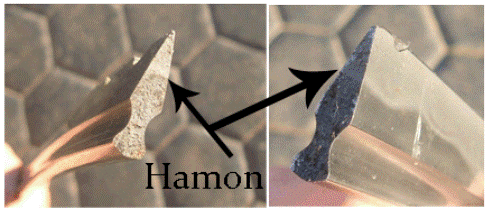 Here we bankrupt a sword in half to await within and come across the hamon. Notice how information technology soaks through the entire section? And then if you do obscure it with a bad polish, it is waiting for y'all to bring out the hamon again using any of the techniques explained a piddling later
Here we bankrupt a sword in half to await within and come across the hamon. Notice how information technology soaks through the entire section? And then if you do obscure it with a bad polish, it is waiting for y'all to bring out the hamon again using any of the techniques explained a piddling later
Ii main styes used to bring out the hamon line - Hadori and Classical Hamon
Don't worry, we are going to get to the 'how to' soon plenty - simply so that you know - there are ii means that bring out the hamon line. The first one results in a whiteish/milky hamon confronting a darker spine called 'hadori' - if you lot look very closely at hadori hamon you lot volition encounter the 'real' hamon beneath it - and this technique is created past acid carving the blade.
The other more than traditional style, the classical fashion, results in a more than subtle, more natural and usually darker colored hamon on a steel background and is sometimes called a 'real' hamon. You can see more examples on this page from the data section of a Nihonto seller in Japan called 'Usagiya'.
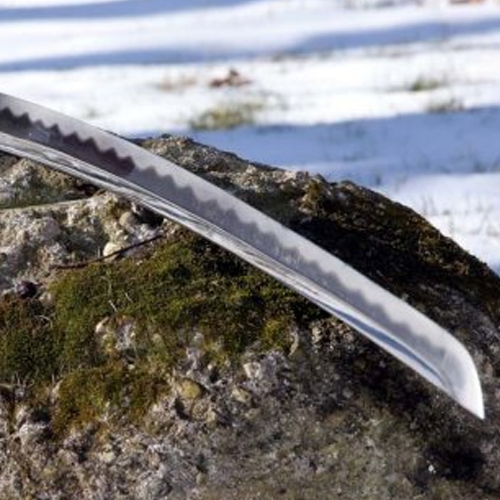 Hadori Polish Hamon
Hadori Polish Hamon
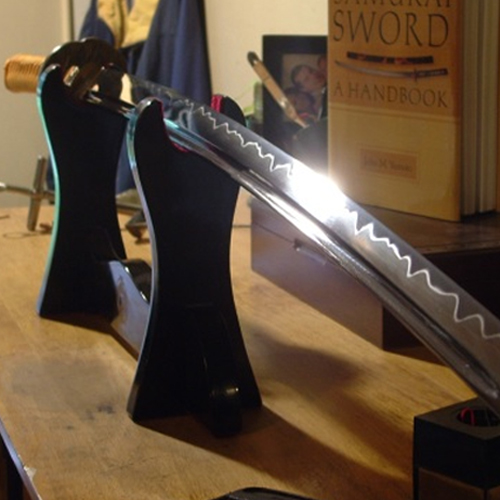 'Real' Hamon
'Real' Hamon
The Just manner to cretae a 'existent' hamon is via the painstaking process involving Japanese h2o stones - and polishing with..
Japanese Water Stones
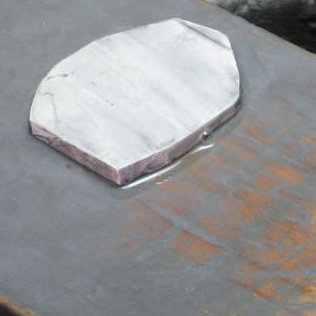
The classical way to bring out a hamon line, the use of Japanese polishing stones, is Asa Mae Shigoto Dewa Nai (not a task to achieve before breakfast) which is an old Japanese expression meaning something that volition accept a looong fourth dimension..
And learning how to exercise it, that will have fifty-fifty longer.. In fact, it unremarkably takes v years for an apprentice to become a swordsmith in Japan, but for a polisher, information technology takes 10..
That's how tricky it is to learn how to polish a hamon using the traditional method..
Every bit such, there is no style nosotros can encompass how to learn this in an online article. The best attempt I have seen is again on the Usagiya site here just there are two big reasons why it is not a skillful idea to just mess around with the techniques and treat them too lightly..
The first reason is that it just takes as well long to larn how to practice it properly. 1 SBG member, benvk, who is himself who is studying the arts of mitt polishing a hamon puts it similar this:
"I can categorically say that if you want learn how to polish these things correctly, exist prepared to sacrifice a hell of a lot of fourth dimension and endeavour. These are not piece of cake skills or techniques to learn and I can only guarantee you frustration and heartache all the style downwards the line.
I'm still very much a novice in this surface area and some days, the frustration is so bad that I just want to snap the blade I'm polishing in half! But, I'm stubborn (you have to be) and I know that one of these days, information technology will all come together in the way I want it to. It might take years simply I'm in for the long haul."
Simply the 2d reason is more businesslike - considering modern steels are and so hard that they are almost incommunicable to practise this style - the imperfect nature of tamahagane ways that the stones tend to 'bite' into it easier, while with mod steels they tend to glide over the surface and have even longer to do and require different techniques than what is used traditionally!
Hybrid Polishing
One modern method of polishing a Japanese blade to bring out the hamon line is called 'Hybrid Polishing' - below is a video which explains the nuts of this much easier and more modern approach vs the traditional on two habitation fabricated differentially hardened knives.
Hybrid polishing, as the name suggests, involves polishing and sharpening the blade first using the techniques outlined on this folio of our site nigh hand sharpening (polishing and sharpening are the same process and usually happen at the same time)
Another short cut approach to the first stage of hybrid polishing is explained in our article - 'Polishing without the Zen'.

And the second stage is to acid etch the blade using lemon or vinegar, hence the name 'hybrid polish'. You can notice more information this technique at the lesser of the folio under 'more resources' - just, this commodity is called the EASIEST way to bring out a hamon line - and in many cases the kickoff stage of the hybrid smoothen is not necessary.
So permit's spring direct to the main methods used to bring out a hamon by casual sword enthusiasts - stuff that we Tin can show you how to do in not in days or weeks, but in minutes and hours..
Acrid Carving Technique - Vinegar or Lemon..
The most mutual mode that about Western sword collectors use to bring out a hamon line is via an acidic compose. This is not as nontraditional as it sounds, equally Japanese polishing stones are also mildly acidic - merely it certainly is easier.
Here is a quick DIY instructional on this method by SBG member Slav.
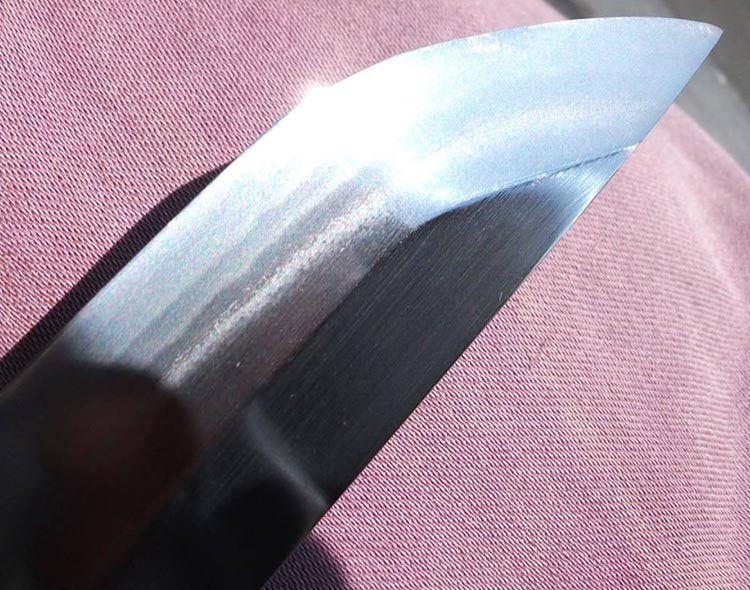 A subtle hamon is revealed using the acid etch method
A subtle hamon is revealed using the acid etch method
Tutorial: How to Do an Acid Etch
Video Tutorial on the same basic technique and principles with a knife
The following info has been put together from many other sources and adapted in a fashion I personally prefer, there is a lot of room for personal experimentation and modification here. Recall that this is not a substitute for a full or modern polish but but adds to the finished look and that this method is for enhancing a real hamon that is really there, not a wire brushed or otherwise false hamon. If your blade has not been differentially heated where the edge is harder than the spine and instead has been through hardened, it well-nigh likely does not have a existent hamon and therefore this technique will not piece of work for you.
This is what has worked best for me and is not the terminal discussion on the subject and then merely use your all-time judgment and do some research.
From what I sympathise, different acids work better for different steel types. I utilize not diluted white or apple tree cider vinegar for 5160 steel with very good results. I take as well used lemon juice (smells horrible when heated!) and ferric chloride to compose with varied results.
I would outset with vinegar or lemons every bit it is probably the easiest and to the lowest degree expensive and so endeavor others to see which works best for yous.
Listing of supplies:
- White or apple cider vinegar (highest acidity possible) or lemons or Ferric chloride (FeCl3)
- Windex, Glass plus or a similar cleaner containing ammonia to neutralize acid
- Mothers mag and bike polish
- Bon Ami mild cleansing powder or other non abrasive grease cutting cleaner
- Newspaper towels or cotton balls
- Dish detergent
- Glass bowl
Prep -
Make sure your blade is very clean before carving. I apply bonami cleansing pulverisation because information technology doesn't get out a balance later rinsing and won't scratch the blade. You lot tin can use like products as long as information technology rinses clean so at that place is no grease or dirt or cleaning residue. be sure to remove all sword parts that can preclude you lot from cleaning the acid off thoroughly such as habaki or baby-sit parts, etc.
Make certain blade is completely dry later cleaning and manifestly try to avert touching it with your bare hands to avert getting oil from your skin on it.
I utilise rubber dish washing gloves every bit the acid can be pretty harsh on your peel and remember to never touch your face up, eyes or mouth with the acrid (washed it before and it's not pleasant)
Footstep ane
I put about 2/iii of a cup (depends on blade size, can exist adapted) of vinegar (or other acid) in a pocket-sized basin or pot with a couple of drops of regular dish soap mixed in (helps even coating) I heat this on the stove (or in microwave in glass bowl) until just before humid.
If possible, you can too heat the blade either in the oven or with quick passes of a mini butane torch until the metal is very warm to hot (not reddish hot or you lot might ruin the temper) this opens the pores in the steel. You can as well use hot water for this.
Once the acrid is heated I then utilize a clean rag or paper towels (or cotton wool assurance on a stick) and repeatedly soak the blade with the solution.
Yous can do this ane side of the blade at a time just be sure to mask the side that you're not etching to forestall stains or rust. I prefer to hold the blade vertically with the tip resting in the bowl (on something soft to not chip or tedious it) and soak both sides at once. soak the rag and start at the mune machi and work your way down towards the tip loosely pinching the sides, you don't accept to "rub" it in.
Keep an eye on the steel and notice when information technology starts to turn a lite to medium greyness, this means it is fully saturated and it's time to stop. Likewise, do not allow the acrid sit or puddle in one area too long because it can cause rusting virtually immediately (if this happens, simply shine it out before standing)
Pace 2
Once you lot are washed with the first etching bicycle (metal turned gray) quickly spray down the blade with windex or glass plus to neutralize the affects of the acrid (key ingredient is ammonia).
Step 3
Clean both sides of the bract with aforementioned cleaner you used to prep, rinse and dry. Lightly smooth the blade with mothers mag and wheel polish to remove the grey especially the shinogi-ji, bo hi (if it has 1) and mune (spine). You don't have to scrub the blade with polish, but follow product directions.
Of import:
Brand certain y'all make clean all the polish residue off of the blade. Use the same cleaners y'all used before just do a very thorough job because whatever rest left on the blade for the adjacent rounds of carving can crusade splotching or streaking.
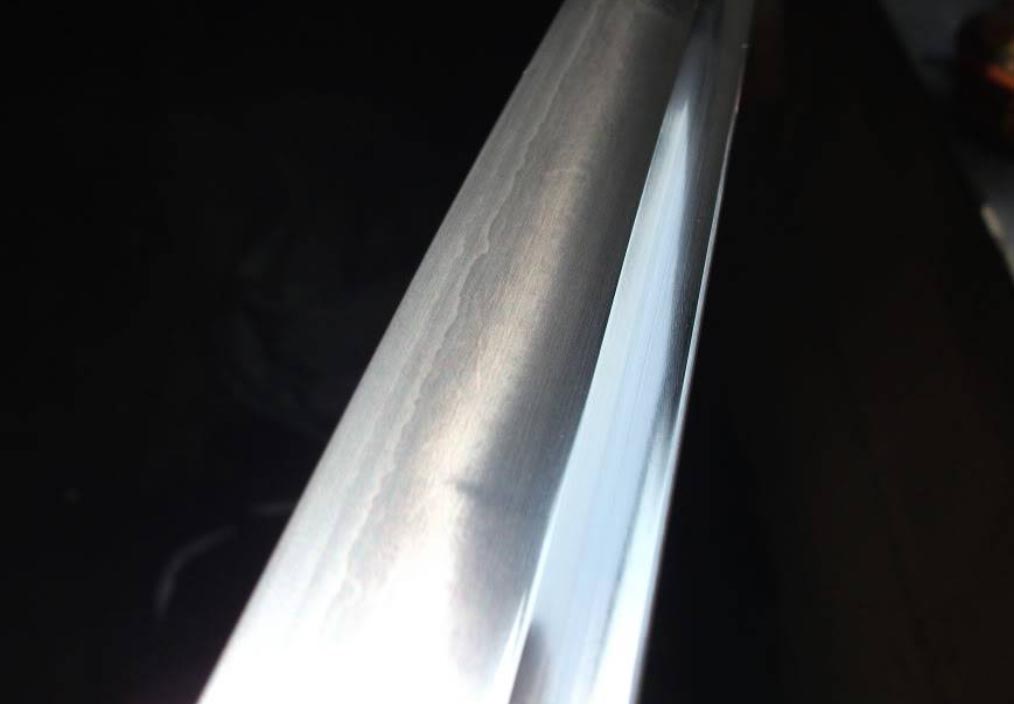
Step 4
Repeat the process.
I find I get the best results by doing virtually five-viii of these short baths every bit opposed to fewer times in longer baths. Information technology seems to bring out more than of the smaller details, If they are in that location to bring out. Non all hamon will have a lot of activity and so terminal results will definitely vary.
Remember to exercise a final smooth with Mothers and so completely clean off whatsoever residue, dry and oil your bract.
This method tin can be contradistinct as you encounter fit and is pretty fail safety as long as you take things set up up well. Yous can always polish out the blade and first again if you lot do not get satisfactory results.
Experiment with different combination's of acids, time lengths, techniques and steel types to find what works best for you.
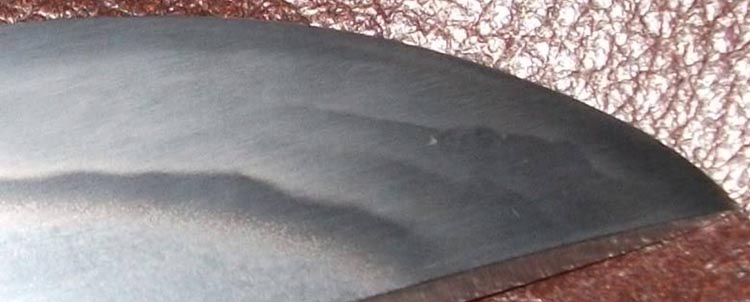
Ferric Chloride
Slav mentioned it briefly in his tutorial, but you can bring out a hamon line when a vinegar acrid etch fails using Ferric Chloride. Just a petty goes a long way with this stuff. Below is a quick account of one SBG members experiences with it.
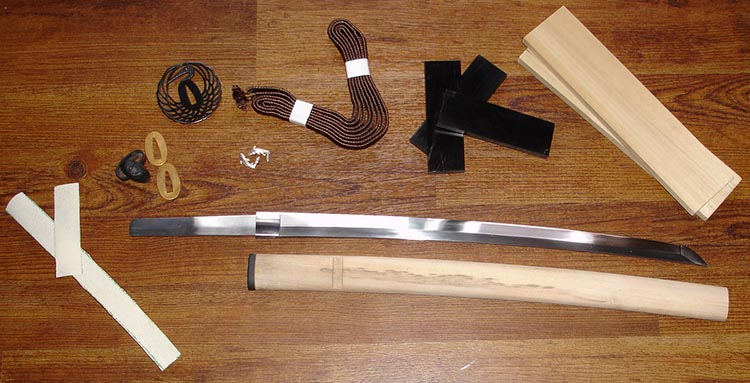 BEFORE - out of the box, the hamon on this Katana was barely visible
BEFORE - out of the box, the hamon on this Katana was barely visible
Tutorial: Ferric Chloride
I got a new Kris Cutlery wazkizashi blade, and every bit information technology came from Cecil, I could but barely see the hamon. Thought I'd etch it upwardly. And so, I:
1. Tried apple cider vinegar, no consequence
2. Tried Lime juice, side by side to no upshot
3. Tried Ferric Chloride, from an electronics store, about 4-1 water/feCl.
Heated the water, mixed it up, and immersed the blade (in a PVC pipe filled with solution).
Waited iii minutes.
Results - over etch, and much cleaning upward needed to go blade dorsum to anywhere near squeamish. I guess with FeCl, and this blade, I didn't need to heat the h2o (or, I could accept used less FeCL).
Note to self - CONTINUALLY Bank check HOW THE Compose IS GOING AND Finish WHEN Enough!:)
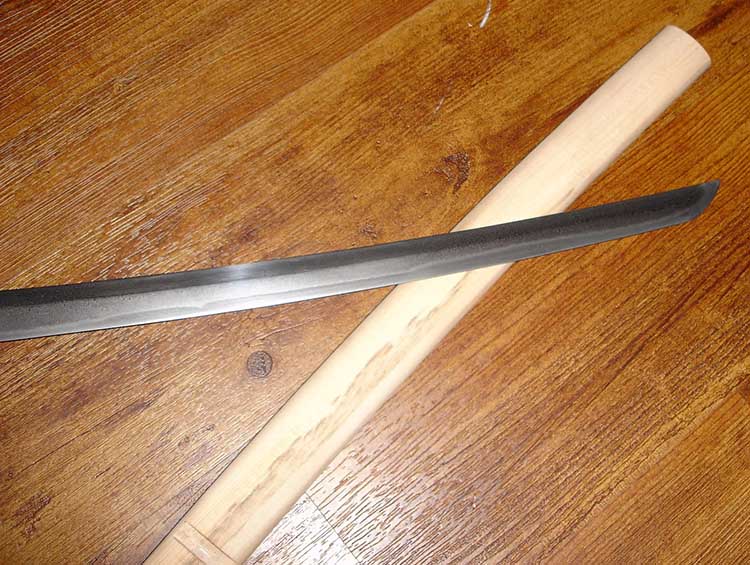 AFTER: It took some trial and error, but in the end this was the consequence
AFTER: It took some trial and error, but in the end this was the consequence
There is some trial and error involved, simply if you lot screw it up you can reset the blade by just polishing the hamon out again and starting over. As you know, the hamon is at that place all the way to the core in a differentially hardened bract just waiting for yous to bring the hamon line out, even if information technology takes a few attempts to hitting the perfect forumla..
Speaking of perfect formula, one final technique - and yes, we take saved the best until final.. ;-)
The EASIEST style to bring out a hamon line!
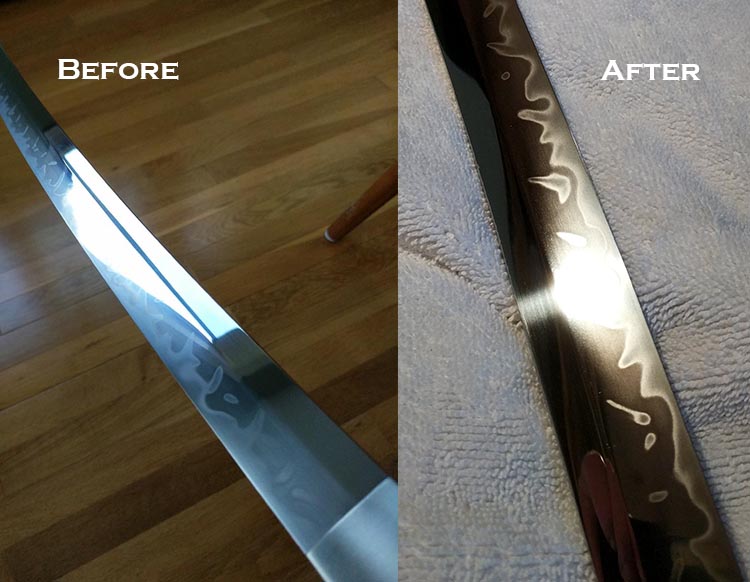
The above motion-picture show shows the results of using this method. Here'south another one..
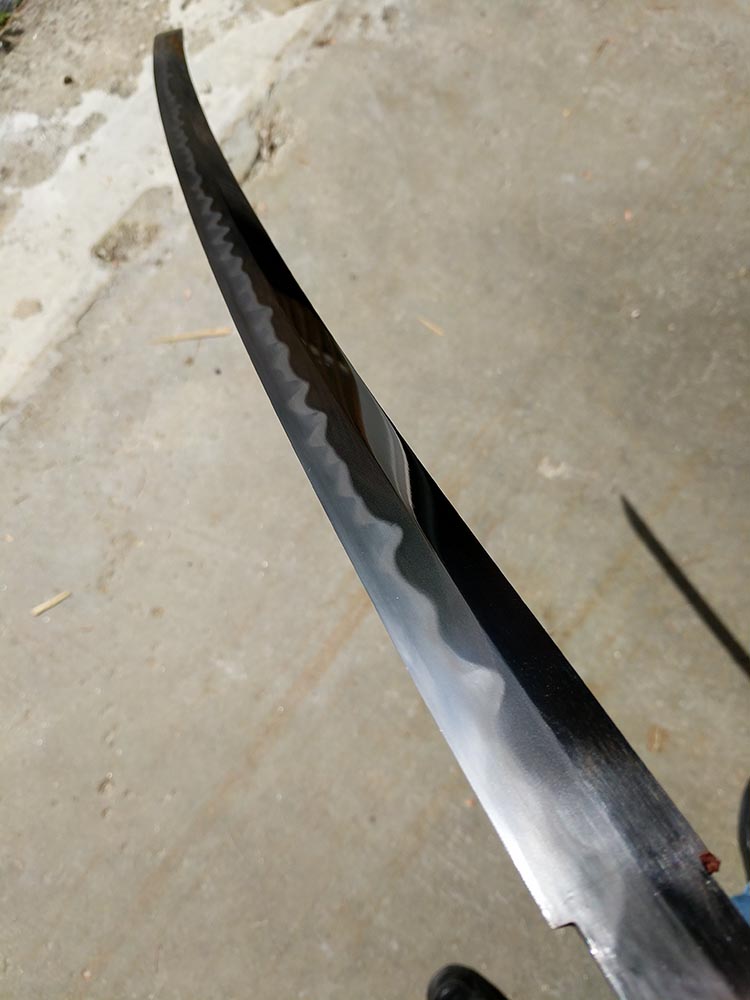
The method here is the Reverse of the normal acid polish and instead of lightening the hamon, it darkens the residuum of the blade to provide the dissimilarity. For an even More than prominent issue, you tin make the hamon bound out using any of the techniques used above, just these ii pictures bear witness just the result of using this method by itself.
What is this mystery method I hear you ask?
Well, all you lot need to do is get some of THIS..
Crimson Iron Oxide
The technique to bring out the hamon line with Red Iron Oxide is very unproblematic.
Firstly go some nail shine and paint to encompass up the surfaces of the hamon to protect it.
Then take some of the fe oxide powder and mix information technology with some lubricating oil such as Hoppes # 9 in the center circle on a coffee saucer to make a polishing paste - not to runny or to thick, just enough and so that it is slightly liquid.
Taking a clean index finger, dab a few tiny dots around an inch apart Beneath the hamon on the section of the steel that you will be darkening - right up to the hamon but non over information technology and polish information technology into the steel with a folded triangular shaped pad.
Once y'all are done, use acetone to clean off the nail polish (nail shine remover) and a light polish with mothers magazine or other polishing compound (such as Silicon Pulverization 1200 grit) wipe information technology off with a fabric or piece of paper and - viola!
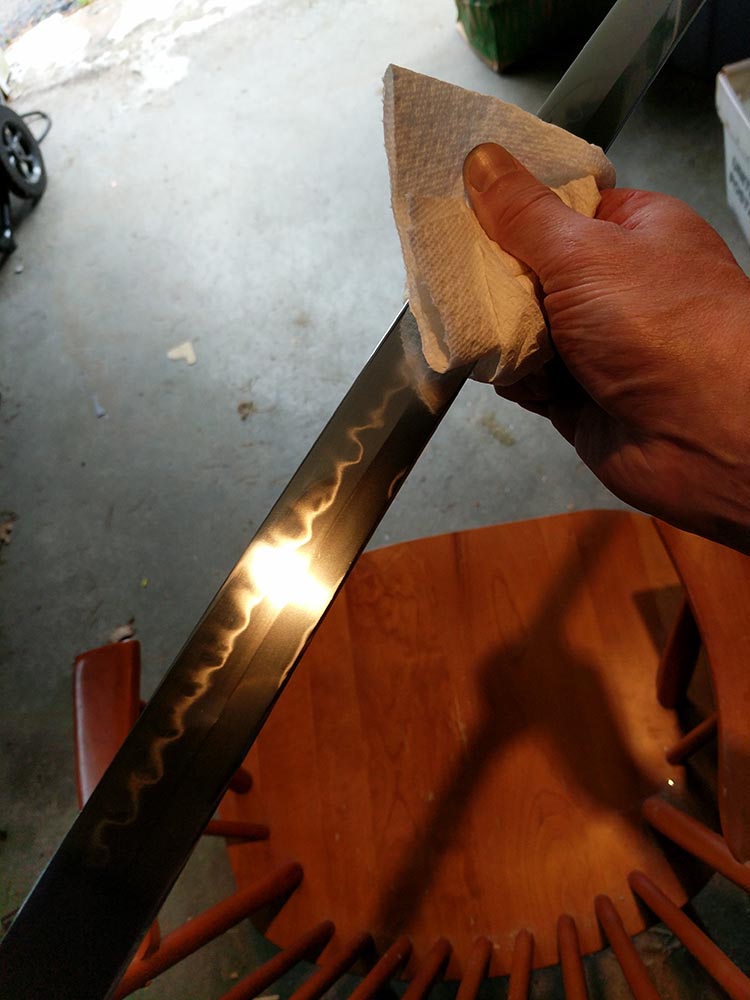
Decision
So at that place y'all have it, the main modern methods used by hobbyists and enthusiasts to bring out a hamon line at home - ranked in the order from hardest to easiest:
- Hybrid polishing
- Acid Etching with Vinegar or Lemon
- Acid Carving with Ferric Chloride (lighten the hamon)
- Acrid Carving with Ruby Iron Oxide (darken the residue of the bract)
Or if all else fails, exercise what some Chinese forges practice to fake a hamon - make a steel template and grind the thing on.. ;-)
Further Resources
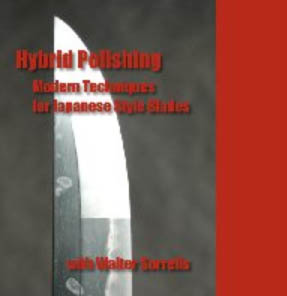
One excellent resource for learning how to do a hybrid polish is the DVD by highly respected sword and blade maker Walter Sorrels entitled "Hybrid Polishing: Japanese Sword Polishing for Modern Blades"
The process of hybrid polishing is also explained in more detail in this short but sweet article hither
And of course you tin get help, advice and read well-nigh other people's results and techniques on both bladeforums.com and of class our very own SBG Sword Forum
I promise this information on how to bringing out a hamon line has been helpful. To return to How to Sharpen a Sword from Easiest ways to bring out a hamon line, click hither
Special thanks to SBG members benvk, verity, slav, jblakey and zgs1313

Ownership Swords Online Can Be Dangerous!
Find the Best Swords in the:
Popular & Recommended Articles

Source: https://www.sword-buyers-guide.com/bring-out-a-hamon-line.html
Posted by: lacoursereupok.blogspot.com


0 Response to "Can I Use Bonami To Clean Oven?"
Post a Comment